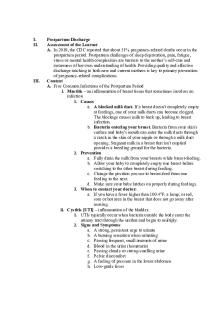Post Myocardial Infarction Discharge Instruction activity PDF

| Title | Post Myocardial Infarction Discharge Instruction activity |
|---|---|
| Course | Multidimensional Care II |
| Institution | Rasmussen University |
| Pages | 2 |
| File Size | 71 KB |
| File Type | |
| Total Downloads | 93 |
| Total Views | 151 |
Summary
this is clinical paperwork. this should help you with the clinical Assessments that you would have last quarter...
Description
Post Myocardial Infarction Discharge Instructions
Please create a post MI discharge instruction handout for patients. Please ensure it is done without medical jargon so the patient can understand. Make it interesting to read. Please site references on the back.
Things to include, but not limited to:
1. Potential medications and things to remember about each
Check that you have a list of all the medicines you take. Take your medicines exactly as directed. Make sure you've been given instructions about your medicines and how to take them. Make sure you have a pharmacy so you can get the prescription filled. Don’t skip doses. Talk with your healthcare provider if your medicines aren't working for you.
2. Activity changes they may need to follow
Chose an activity that you enjoy such as walking (outside or on a treadmill), stationary cycling, rowing or water aerobics. Ask your doctor before lifting weights. Exercise should be done regularly to gain the benefits; national guidelines suggest most days of the week if not every day.
3. Diet changes
Cutting back on how much fat and cholesterol you eat
Cutting back on how much salt (sodium) you eat, especially if you have high blood pressure
Eating more fresh vegetables and fruits
Eating lean proteins such as fish, poultry, beans, and peas, and eating less red meat and processed meats
Using low-fat dairy products
Using vegetable and nut oils in limited amounts
Limiting how many sweets and processed foods such as chips, cookies, and baked goods you eat
Limiting how often you eat out. And when you do eat out, making better food choices.
Not eating fried or greasy foods, or foods high in saturated fat
4. When to return to ED or office
Call 911 right away if you have chest pain or pain that goes to your shoulder, neck, or back. Don't drive yourself to the hospital.
5. Resources for patient while at home
Ask your family members to learn CPR. This is an important skill that can save lives when it's needed. Learn to take your own blood pressure and pulse. Keep a record of your results. Ask your doctor when you should seek help if experiencing mild to severe feeling of pressure, squeezing, fullness or pain in the center or left side of the chest that lasts more than a few minutes or goes away and comes back....
Similar Free PDFs

Discharge of Contracts
- 5 Pages

Discharge by Agreement
- 9 Pages
Popular Institutions
- Tinajero National High School - Annex
- Politeknik Caltex Riau
- Yokohama City University
- SGT University
- University of Al-Qadisiyah
- Divine Word College of Vigan
- Techniek College Rotterdam
- Universidade de Santiago
- Universiti Teknologi MARA Cawangan Johor Kampus Pasir Gudang
- Poltekkes Kemenkes Yogyakarta
- Baguio City National High School
- Colegio san marcos
- preparatoria uno
- Centro de Bachillerato Tecnológico Industrial y de Servicios No. 107
- Dalian Maritime University
- Quang Trung Secondary School
- Colegio Tecnológico en Informática
- Corporación Regional de Educación Superior
- Grupo CEDVA
- Dar Al Uloom University
- Centro de Estudios Preuniversitarios de la Universidad Nacional de Ingeniería
- 上智大学
- Aakash International School, Nuna Majara
- San Felipe Neri Catholic School
- Kang Chiao International School - New Taipei City
- Misamis Occidental National High School
- Institución Educativa Escuela Normal Juan Ladrilleros
- Kolehiyo ng Pantukan
- Batanes State College
- Instituto Continental
- Sekolah Menengah Kejuruan Kesehatan Kaltara (Tarakan)
- Colegio de La Inmaculada Concepcion - Cebu













